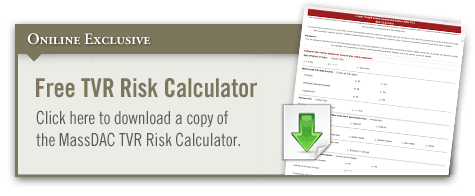Research has shown that drug-eluting stents (DES) effectively help reduce restenosis, with a 50% to 70% relative risk reduction in target vessel revascularization (TVR) rates. “Drug-eluting stents have been an important technological innovation,” explains Robert W. Yeh, MD, MSc, “but their benefits are concentrated to subsets of patients at higher risk of restenosis with bare-metal stents (BMS). As a result, some studies have suggested that DES be targeted selectively to the higher- TVR-risk lesions.”
Examining the use of DES as a function of patients’ TVR risk may have important implications regarding the costs of PCI. Economic analyses in clinical trials have shown that DES is generally cost-effective for patients at moderate or high risk of restenosis, but a recent study has found that the annual costs associated with DES use were $1.57 billion between 2002 and 2006. In addition, DES use currently requires prolonged dual-antiplatelet therapy when used in stable patients, whereas BMS does not. DES therapy can increase long-term medication costs and elevate patients’ risk of bleeding events. Patients can also be subjected to serious complications if dual-antiplatelet therapy is discontinued prematurely.
DES Use Variations
Dr. Yeh and colleagues conducted a study to assess whether DES are preferentially used in patients with higher predicted TVR risk. The analysis, which was published in the July 9, 2012 Archives of Internal Medicine, also sought to estimate if lower use of DES in low-TVR-risk patients would be more cost-effective than how DES are currently being used. “Given the financial pressures on the nation’s healthcare system today,” Dr. Yeh says, “efforts are warranted to more closely examine the decisions being made when treating restenosis.”
After analyzing data from more than 1.5 million PCI procedures in the National Cardiovascular Data Registry CathPCI registry, Dr. Yeh and colleagues found wide variation in the use of DES (Figure 1), suggesting overuse for patients at low risk of restenosis and room for cost savings. Rates varied significantly among physicians, from exclusive use of DES to almost exclusive use of BMS. DES use varied only modestly by patients’ 1-year target vessel restenosis risk (relative risk, 1.005 per 1% higher restenosis risk). The proportion of patients in the study receiving a DES rather than BMS was: 73.9%
73.9% among patients at low risk (<10%) of restenosis.
78.0% among patients at intermediate risk (10% to 20%) over 1 year.
83.2% among patients at high projected restenosis risk (>20%).
Cost Considerations: DES vs BMS
In the study, projected costs were sensitive to changes in DES use over BMS in the low-restenosis-risk group. Restenosis events were estimated to increase only slightly. If drug-eluting stent use dropped by 50% in the low-risk group, the projected savings would reach nearly $205 million per year in the U.S. (or $34,109 per 100 PCI performed) while resulting in only a 0.5% increase in the restenosis event rate.
“This strategy could present an important opportunity to reduce healthcare expenditures while preserving clinical benefit,” adds Dr. Yeh. “Since TVR usually has only a modest impact on quality of life and negligible impact on lifespan, this economic trade-off can be considered acceptable. Some patients may prefer to take on this small added risk of requiring a repeat procedure in order to avoid the risks and costs of prolonged antiplatelet therapy, which we are learning are not trivial.” In probabilistic sensitivity analyses, the incremental cost-effectiveness ratio remained higher than $10,000 per TVR in 98.3% of simulations (Figure 2).
Calculating Restenosis Risk
Implementing strategies that incorporate the predicted benefit of interventions into practice remains a considerable challenge. However, Dr. Yeh says the MassDAC TVR risk prediction model could offer an evidencebased solution. The model could be used to prospectively inform clinicians and patients of TVR risk prior to stent implantation. “The MassDAC TVR model could promote evidence-based care and shared decision making with patients,” Dr. Yeh adds. “It can integrate patient preferences for small reductions in TVR with their desires to adhere to dual-antiplatelet therapy and its potential costs and bleeding risks.”
It may be challenging to integrate risk prediction into routine practice because of the fast-paced nature of delivering cardiac care. But Dr. Yeh says efforts are underway to facilitate use of such prediction tools. “We’re working on integrating the calculator into bedside care with new technology,” he says. “We hope to find better ways to integrate prediction tools so that it’s easier for clinicians to use them to their complete advantage.”




 TimH
TimH